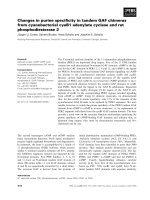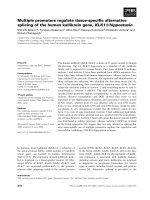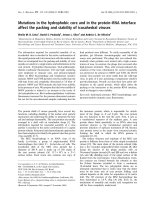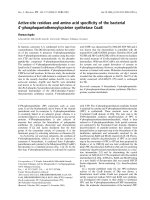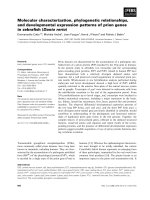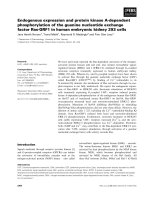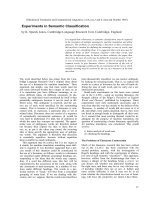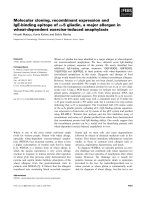Báo cáo khoa học: "Conundrums in Noun Phrase Coreference Resolution: Making Sense of the State-of-the-Art" docx
Bạn đang xem bản rút gọn của tài liệu. Xem và tải ngay bản đầy đủ của tài liệu tại đây (155.18 KB, 9 trang )
Proceedings of the 47th Annual Meeting of the ACL and the 4th IJCNLP of the AFNLP, pages 656–664,
Suntec, Singapore, 2-7 August 2009.
c
2009 ACL and AFNLP
Conundrums in Noun Phrase Coreference Resolution:
Making Sense of the State-of-the-Art
Veselin Stoyanov
Cornell University
Ithaca, NY
Nathan Gilbert
University of Utah
Salt Lake City, UT
Claire Cardie
Cornell University
Ithaca, NY
Ellen Riloff
University of Utah
Salt Lake City, UT
Abstract
We aim to shed light on the state-of-the-art in NP
coreference resolution by teasing apart the differ-
ences in the MUC and ACE task definitions, the as-
sumptions made in evaluation methodologies, and
inherent differences in text corpora. First, we exam-
ine three subproblems that play a role in coreference
resolution: named entity recognition, anaphoric-
ity determination, and coreference element detec-
tion. We measure the impact of each subproblem on
coreference resolution and confirm that certain as-
sumptions regarding these subproblems in the eval-
uation methodology can dramatically simplify the
overall task. Second, we measure the performance
of a state-of-the-art coreference resolver on several
classes of anaphora and use these results to develop
a quantitative measure for estimating coreference
resolution performance on new data sets.
1 Introduction
As is common for many natural language process-
ing problems, the state-of-the-art in noun phrase
(NP) coreference resolution is typically quantified
based on system performance on manually anno-
tated text corpora. In spite of the availability of
several benchmark data sets (e.g. MUC-6 (1995),
ACE NIST (2004)) and their use in many formal
evaluations, as a field we can make surprisingly
few conclusive statements about the state-of-the-
art in NP coreference resolution.
In particular, it remains difficult to assess the ef-
fectiveness of different coreference resolution ap-
proaches, even in relative terms. For example, the
91.5 F-measure reported by McCallum and Well-
ner (2004) was produced by a system using perfect
information for several linguistic subproblems. In
contrast, the 71.3 F-measure reported by Yang et
al. (2003) represents a fully automatic end-to-end
resolver. It is impossible to assess which approach
truly performs best because of the dramatically
different assumptions of each evaluation.
Results vary widely across data sets. Corefer-
ence resolution scores range from 85-90% on the
ACE 2004 and 2005 data sets to a much lower 60-
70% on the MUC 6 and 7 data sets (e.g. Soon et al.
(2001) and Yang et al. (2003)). What accounts for
these differences? Are they due to properties of
the documents or domains? Or do differences in
the coreference task definitions account for the dif-
ferences in performance? Given a new text collec-
tion and domain, what level of performance should
we expect?
We have little understanding of which aspects
of the coreference resolution problem are handled
well or poorly by state-of-the-art systems. Ex-
cept for some fairly general statements, for exam-
ple that proper names are easier to resolve than
pronouns, which are easier than common nouns,
there has been little analysis of which aspects of
the problem have achieved success and which re-
main elusive.
The goal of this paper is to take initial steps to-
ward making sense of the disparate performance
results reported for NP coreference resolution. For
our investigations, we employ a state-of-the-art
classification-based NP coreference resolver and
focus on the widely used MUC and ACE corefer-
ence resolution data sets.
We hypothesize that performance variation
within and across coreference resolvers is, at least
in part, a function of (1) the (sometimes unstated)
assumptions in evaluation methodologies, and (2)
the relative difficulty of the benchmark text cor-
pora. With these in mind, Section 3 first examines
three subproblems that play an important role in
coreference resolution: named entity recognition,
anaphoricity determination, and coreference ele-
ment detection. We quantitatively measure the im-
pact of each of these subproblems on coreference
resolution performance as a whole. Our results
suggest that the availability of accurate detectors
for anaphoricity or coreference elements could
substantially improve the performance of state-of-
the-art resolvers, while improvements to named
entity recognition likely offer little gains. Our re-
sults also confirm that the assumptions adopted in
656
MUC ACE
Relative Pronouns no yes
Gerunds no yes
Nested non-NP nouns yes no
Nested NEs no GPE & LOC premod
Semantic Types all 7 classes only
Singletons no yes
Table 1: Coreference Definition Differences for MUC and
ACE. (GPE refers to geo-political entities.)
some evaluations dramatically simplify the resolu-
tion task, rendering it an unrealistic surrogate for
the original problem.
In Section 4, we quantify the difficulty of a
text corpus with respect to coreference resolution
by analyzing performance on different resolution
classes. Our goals are twofold: to measure the
level of performance of state-of-the-art corefer-
ence resolvers on different types of anaphora, and
to develop a quantitative measure for estimating
coreference resolution performance on new data
sets. We introduce a coreference performance pre-
diction (CPP) measure and show that it accurately
predicts the performance of our coreference re-
solver. As a side effect of our research, we pro-
vide a new set of much-needed benchmark results
for coreference resolution under common sets of
fully-specified evaluation assumptions.
2 Coreference Task Definitions
This paper studies the six most commonly used
coreference resolution data sets. Two of those are
from the MUC conferences (MUC-6, 1995; MUC-
7, 1997) and four are from the Automatic Con-
tent Evaluation (ACE) Program (NIST, 2004). In
this section, we outline the differences between the
MUC and ACE coreference resolution tasks, and
define terminology for the rest of the paper.
Noun phrase coreference resolution is the pro-
cess of determining whether two noun phrases
(NPs) refer to the same real-world entity or con-
cept. It is related to anaphora resolution: a NP is
said to be anaphoric if it depends on another NP
for interpretation. Consider the following:
John Hall is the new CEO. He starts on Monday.
Here, he is anaphoric because it depends on its an-
tecedent, John Hall, for interpretation. The two
NPs also corefer because each refers to the same
person, JOHN HALL.
As discussed in depth elsewhere (e.g. van
Deemter and Kibble (2000)), the notions of coref-
erence and anaphora are difficult to define pre-
cisely and to operationalize consistently. Further-
more, the connections between them are extremely
complex and go beyond the scope of this paper.
Given these complexities, it is not surprising that
the annotation instructions for the MUC and ACE
data sets reflect different interpretations and sim-
plifications of the general coreference relation. We
outline some of these differences below.
Syntactic Types. To avoid ambiguity, we will
use the term coreference element (CE) to refer
to the set of linguistic expressions that participate
in the coreference relation, as defined for each of
the MUC and ACE tasks.
1
At times, it will be im-
portant to distinguish between the CEs that are in-
cluded in the gold standard — the annotated CEs
— from those that are generated by the corefer-
ence resolution system — the extracted CEs.
At a high level, both the MUC and ACE eval-
uations define CEs as nouns, pronouns, and noun
phrases. However, the MUC definition excludes
(1) “nested” named entities (NEs) (e.g. “Amer-
ica” in “Bank of America”), (2) relative pronouns,
and (3) gerunds, but allows (4) nested nouns (e.g.
“union” in “union members”). The ACE defini-
tion, on the other hand, includes relative pronouns
and gerunds, excludes all nested nouns that are not
themselves NPs, and allows premodifier NE men-
tions of geo-political entities and locations, such
as “Russian” in “Russian politicians”.
Semantic Types. ACE restricts CEs to entities
that belong to one of seven semantic classes: per-
son, organization, geo-political entity, location, fa-
cility, vehicle, and weapon. MUC has no semantic
restrictions.
Singletons. The MUC data sets include annota-
tions only for CEs that are coreferent with at least
one other CE. ACE, on the other hand, permits
“singleton” CEs, which are not coreferent with
any other CE in the document.
These substantial differences in the task defini-
tions (summarized in Table 1) make it extremely
difficult to compare performance across the MUC
and ACE data sets. In the next section, we take a
closer look at the coreference resolution task, ana-
lyzing the impact of various subtasks irrespective
of the data set differences.
1
We define the term CE to be roughly equivalent to (a)
the notion of markable in the MUC coreference resolution
definition and (b) the structures that can be mentions in the
descriptions of ACE.
657
3 Coreference Subtask Analysis
Coreference resolution is a complex task that
requires solving numerous non-trivial subtasks
such as syntactic analysis, semantic class tagging,
pleonastic pronoun identification and antecedent
identification to name a few. This section exam-
ines the role of three such subtasks — named en-
tity recognition, anaphoricity determination, and
coreference element detection — in the perfor-
mance of an end-to-end coreference resolution
system. First, however, we describe the corefer-
ence resolver that we use for our study.
3.1 The RECONCILE
ACL09
Coreference
Resolver
We use the RECONCILE coreference resolution
platform (Stoyanov et al., 2009) to configure a
coreference resolver that performs comparably to
state-of-the-art systems (when evaluated on the
MUC and ACE data sets under comparable as-
sumptions). This system is a classification-based
coreference resolver, modeled after the systems of
Ng and Cardie (2002b) and Bengtson and Roth
(2008). First it classifies pairs of CEs as coreferent
or not coreferent, pairing each identified CE with
all preceding CEs. The CEs are then clustered
into coreference chains
2
based on the pairwise de-
cisions. RECONCILE has a pipeline architecture
with four main steps: preprocessing, feature ex-
traction, classification, and clustering. We will
refer to the specific configuration of RECONCILE
used for this paper as RECONCILE
ACL09
.
Preprocessing. The RECONCILE
ACL09
prepro-
cessor applies a series of language analysis tools
(mostly publicly available software packages) to
the source texts. The OpenNLP toolkit (Baldridge,
J., 2005) performs tokenization, sentence splitting,
and part-of-speech tagging. The Berkeley parser
(Petrov and Klein, 2007) generates phrase struc-
ture parse trees, and the de Marneffe et al. (2006)
system produces dependency relations. We em-
ploy the Stanford CRF-based Named Entity Rec-
ognizer (Finkel et al., 2004) for named entity
tagging. With these preprocessing components,
RECONCILE
ACL09
uses heuristics to correctly ex-
tract approximately 90% of the annotated CEs for
the MUC and ACE data sets.
Feature Set. To achieve roughly state-of-the-
art performance, RECONCILE
ACL09
employs a
2
A coreference chain refers to the set of CEs that refer to
a particular entity.
dataset docs CEs chains CEs/ch tr/tst split
MUC6 60 4232 960 4.4 30/30 (st)
MUC7 50 4297 1081 3.9 30/20 (st)
ACE-2 159 2630 1148 2.3 130/29 (st)
ACE03 105 3106 1340 2.3 74/31
ACE04 128 3037 1332 2.3 90/38
ACE05 81 1991 775 2.6 57/24
Table 2: Dataset characteristics including the number of
documents, annotated CEs, coreference chains, annotated
CEs per chain (average), and number of documents in the
train/test split. We use st to indicate a standard train/test split.
fairly comprehensive set of 61 features introduced
in previous coreference resolution systems (see
Bengtson and Roth (2008)). We briefly summarize
the features here and refer the reader to Stoyanov
et al. (2009) for more details.
Lexical (9): String-based comparisons of the two
CEs, such as exact string matching and head noun
matching.
Proximity (5): Sentence and paragraph-based
measures of the distance between two CEs.
Grammatical (28): A wide variety of syntactic
properties of the CEs, either individually or as a
pair. These features are based on part-of-speech
tags, parse trees, or dependency relations. For ex-
ample: one feature indicates whether both CEs are
syntactic subjects; another indicates whether the
CEs are in an appositive construction.
Semantic (19): Capture semantic information
about one or both NPs such as tests for gender and
animacy, semantic compatibility based on Word-
Net, and semantic comparisons of NE types.
Classification and Clustering. We configure
RECONCILE
ACL09
to use the Averaged Percep-
tron learning algorithm (Freund and Schapire,
1999) and to employ single-link clustering (i.e.
transitive closure) to generate the final partition-
ing.
3
3.2 Baseline System Results
Our experiments rely on the MUC and ACE cor-
pora. For ACE, we use only the newswire portion
because it is closest in composition to the MUC
corpora. Statistics for each of the data sets are
shown in Table 2. When available, we use the
standard test/train split. Otherwise, we randomly
split the data into a training and test set following
a 70/30 ratio.
3
In trial runs, we investigated alternative classification
and clustering models (e.g. C4.5 decision trees and SVMs;
best-first clustering). The results were comparable.
658
Scoring Algorithms. We evaluate using two
common scoring algorithms
4
— MUC and B
3
.
The MUC scoring algorithm (Vilain et al., 1995)
computes the F1 score (harmonic mean) of preci-
sion and recall based on the identifcation of unique
coreference links. We use the official MUC scorer
implementation for the two MUC corpora and an
equivalent implementation for ACE.
The B
3
algorithm (Bagga and Baldwin, 1998)
computes a precision and recall score for each CE:
precision(ce) = |R
ce
∩ K
ce
|/|R
ce
|
recall(ce) = |R
ce
∩ K
ce
|/|K
ce
|,
where R
ce
is the coreference chain to which ce is
assigned in the response (i.e. the system-generated
output) and K
ce
is the coreference chain that con-
tains ce in the key (i.e. the gold standard). Pre-
cision and recall for a set of documents are com-
puted as the mean over all CEs in the documents
and the F1 score of precision and recall is reported.
B
3
Complications. Unlike the MUC score,
which counts links between CEs, B
3
presumes
that the gold standard and the system response are
clusterings over the same set of CEs. This, of
course, is not the case when the system automat-
ically identifies the CEs, so the scoring algorithm
requires a mapping between extracted and anno-
tated CEs. We will use the term twin(ce) to refer
to the unique annotated/extracted CE to which the
extracted/annotated CE is matched. We say that
a CE is twinless (has no twin) if no corresponding
CE is identified. A twinless extracted CE signals
that the resolver extracted a spurious CE, while an
annotated CE is twinless when the resolver fails to
extract it.
Unfortunately, it is unclear how the B
3
score
should be computed for twinless CEs. Bengtson
and Roth (2008) simply discard twinless CEs, but
this solution is likely too lenient — it doles no pun-
ishment for mistakes on twinless annotated or ex-
tracted CEs and it would be tricked, for example,
by a system that extracts only the CEs about which
it is most confident.
We propose two different ways to deal with
twinless CEs for B
3
. One option, B
3
all, retains
all twinless extracted CEs. It computes the preci-
4
We also experimented with the CEAF score (Luo, 2005),
but excluded it due to difficulties dealing with the extracted,
rather than annotated, CEs. CEAF assigns a zero score to
each twinless extracted CE and weights all coreference chains
equally, irrespective of their size. As a result, runs with ex-
tracted CEs exhibit very low CEAF precision, leading to un-
reliable scores.
sion as above when ce has a twin, and computes
the precision as 1/|R
ce
| if ce is twinless. (Simi-
larly, recall(ce) = 1/|K
ce
| if ce is twinless.)
The second option, B
3
0, discards twinless
extracted CEs, but penalizes recall by setting
recall(ce) = 0 for all twinless annotated CEs.
Thus, B
3
0 presumes that all twinless extracted
CEs are spurious.
Results. Table 3, box 1 shows the performance
of RECONCILE
ACL09
using a default (0.5) coref-
erence classifier threshold. The MUC score is
highest for the MUC6 data set, while the four ACE
data sets show much higher B
3
scores as com-
pared to the two MUC data sets. The latter occurs
because the ACE data sets include singletons.
The classification threshold, however, can be
gainfully employed to control the trade-off be-
tween precision and recall. This has not tradi-
tionally been done in learning-based coreference
resolution research — possibly because there is
not much training data available to sacrifice as a
validation set. Nonetheless, we hypothesized that
estimating a threshold from just the training data
might be effective. Our results (BASELINE box
in Table 3) indicate that this indeed works well.
5
With the exception of MUC6, results on all data
sets and for all scoring algorithms improve; more-
over, the scores approach those for runs using an
optimal threshold (box 3) for the experiment as de-
termined by using the test set. In all remaining ex-
periments, we learn the threshold from the training
set as in the BASELINE system.
Below, we resume our investigation of the role
of three coreference resolution subtasks and mea-
sure the impact of each on overall performance.
3.3 Named Entities
Previous work has shown that resolving corefer-
ence between proper names is relatively easy (e.g.
Kameyama (1997)) because string matching func-
tions specialized to the type of proper name (e.g.
person vs. location) are quite accurate. Thus, we
would expect a coreference resolution system to
depend critically on its Named Entity (NE) extrac-
tor. On the other hand, state-of-the-art NE taggers
are already quite good, so improving this compo-
nent may not provide much additional gain.
To study the influence of NE recognition,
we replace the system-generated NEs of
5
All experiments sample uniformly from 1000 threshold
values.
659
Reconcile
ACL09
MUC6 MUC7 ACE-2 ACE03 ACE04 ACE05
1. DEFAULT THRESHOLD (0.5)
M U C 70.40 58.20 65.76 66.73 56.75 64.30
B
3
all 69.91 62.88 77.25 77.56 73.03 72.82
B
3
0 68.55 62.80 76.59 77.27 72.99 72.43
2. BASELINE
M U C 68.50 62.80 65.99 67.87 62.03 67.41
= THRESHOLD ESTIMATION
B
3
all 70.88 65.86 78.29 79.39 76.50 73.71
B
3
0 68.43 64.57 76.63 77.88 75.41 72.47
3. OPTIMAL THRESHOLD
M U C 71.20 62.90 66.83 68.35 62.11 67.41
B
3
all 72.31 66.52 78.50 79.41 76.53 74.25
B
3
0 69.49 64.64 76.83 78.27 75.51 72.94
4. BASELINE with
M U C 69.90 - 66.37 70.35 62.88 67.72
perfect NEs
B
3
all 72.31 - 78.06 80.22 77.01 73.92
B
3
0 67.91 - 76.55 78.35 75.22 72.90
5. BASELINE with
M U C 85.80* 81.10* 76.39 79.68 76.18 79.42
perfect CEs
B
3
all 76.14 75.88 78.65 80.58 77.79 76.49
B
3
0 76.14 75.88 78.65 80.58 77.79 76.49
6. BASELINE with
M U C 82.20* 71.90* 86.63 85.58 83.33 82.84
anaphoric CEs
B
3
all 72.52 69.26 80.29 79.71 76.05 74.33
B
3
0 72.52 69.26 80.29 79.71 76.05 74.33
Table 3: Impact of Three Subtasks on Coreference Resolution Performance. A score marked with a * indicates that a 0.5
threshold was used because threshold selection from the training data resulted in an extreme version of the system, i.e. one that
places all CEs into a single coreference chain.
RECONCILE
ACL09
with gold-standard NEs
and retrain the coreference classifier. Results
for each of the data sets are shown in box 4 of
Table 3. (No gold standard NEs are available for
MUC7.) Comparison to the BASELINE system
(box 2) shows that using gold standard NEs
leads to improvements on all data sets with the
exception of ACE2 and ACE05, on which perfor-
mance is virtually unchanged. The improvements
tend to be small, however, between 0.5 to 3
performance points. We attribute this to two
factors. First, as noted above, although far from
perfect, NE taggers generally perform reasonably
well. Second, only 20 to 25% of the coreference
element resolutions required for these data sets
involve a proper name (see Section 4).
Conclusion #1: Improving the performance of NE tag-
gers is not likely to have a large impact on the performance
of state-of-the-art coreference resolution systems.
3.4 Coreference Element Detection
We expect CE detection to be an important sub-
problem for an end-to-end coreference system.
Results for a system that assumes perfect CEs
are shown in box 5 of Table 3. For these runs,
RECONCILE
ACL09
uses only the annotated CEs
for both training and testing. Using perfect CEs
solves a large part of the coreference resolution
task: the annotated CEs divulge anaphoricity in-
formation, perfect NP boundaries, and perfect in-
formation regarding the coreference relation de-
fined for the data set.
We see that focusing attention on all and only
the annotated CEs leads to (often substantial) im-
provements in performance on all metrics over
all data sets, especially when measured using the
MUC score.
Conclusion #2: Improving the ability of coreference re-
solvers to identify coreference elements would likely improve
the state-of-the-art immensely — by 10-20 points in MUC F1
score and from 2-12 F1 points for B
3
.
This finding explains previously published re-
sults that exhibit striking variability when run with
annotated CEs vs. system-extracted CEs. On the
MUC6 data set, for example, the best published
MUC score using extracted CEs is approximately
71 (Yang et al., 2003), while multiple systems
have produced MUC scores of approximately 85
when using annotated CEs (e.g. Luo et al. (2004),
McCallum and Wellner (2004)).
We argue that providing a resolver with the an-
notated CEs is a rather unrealistic evaluation: de-
termining whether an NP is part of an annotated
coreference chain is precisely the job of a corefer-
ence resolver!
Conclusion #3: Assuming the availability of CEs unre-
alistically simplifies the coreference resolution task.
3.5 Anaphoricity Determination
Finally, several coreference systems have suc-
cessfully incorporated anaphoricity determination
660
modules (e.g. Ng and Cardie (2002a) and Bean
and Riloff (2004)). The goal of the module is to
determine whether or not an NP is anaphoric. For
example, pleonastic pronouns (e.g. it is raining)
are special cases that do not require coreference
resolution.
Unfortunately, neither the MUC nor the ACE
data sets include anaphoricity information for all
NPs. Rather, they encode anaphoricity informa-
tion implicitly for annotated CEs: a CE is consid-
ered anaphoric if is not a singleton.
6
To study the utility of anaphoricity informa-
tion, we train and test only on the “anaphoric” ex-
tracted CEs, i.e. the extracted CEs that have an
annotated twin that is not a singleton. Note that
for the MUC datasets all extracted CEs that have
twins are considered anaphoric.
Results for this experiment (box 6 in Table 3)
are similar to the previous experiment using per-
fect CEs: we observe big improvements across the
board. This should not be surprising since the ex-
perimental setting is quite close to that for perfect
CEs: this experiment also presumes knowledge
of when a CE is part of an annotated coreference
chain. Nevertheless, we see that anaphoricity info-
mation is important. First, good anaphoricity iden-
tification should reduce the set of extracted CEs
making it closer to the set of annotated CEs. Sec-
ond, further improvements in MUC score for the
ACE data sets over the runs using perfect CEs (box
5) reveal that accurately determining anaphoric-
ity can lead to substantial improvements in MUC
score. ACE data includes annotations for single-
ton CEs, so knowling whether an annotated CE is
anaphoric divulges additional information.
Conclusion #4: An accurate anaphoricity determina-
tion component can lead to substantial improvement in coref-
erence resolution performance.
4 Resolution Complexity
Different types of anaphora that have to be han-
dled by coreference resolution systems exhibit dif-
ferent properties. In linguistic theory, binding
mechanisms vary for different kinds of syntactic
constituents and structures. And in practice, em-
pirical results have confirmed intuitions that differ-
ent types of anaphora benefit from different clas-
sifier features and exhibit varying degrees of diffi-
culty (Kameyama, 1997). However, performance
6
Also, the first element of a coreference chain is usually
non-anaphoric, but we do not consider that issue here.
evaluations rarely include analysis of where state-
of-the-art coreference resolvers perform best and
worst, aside from general conclusions.
In this section, we analyze the behavior of
our coreference resolver on different types of
anaphoric expressions with two goals in mind.
First, we want to deduce the strengths and weak-
nesses of state-of-the-art systems to help direct
future research. Second, we aim to understand
why current coreference resolvers behave so in-
consistently across data sets. Our hypothesis is
that the distribution of different types of anaphoric
expressions in a corpus is a major factor for coref-
erence resolution performance. Our experiments
confirm this hypothesis and we use our empirical
results to create a coreference performance predic-
tion (CPP) measure that successfully estimates the
expected level of performance on novel data sets.
4.1 Resolution Classes
We study the resolution complexity of a text cor-
pus by defining resolution classes. Resolution
classes partition the set of anaphoric CEs accord-
ing to properties of the anaphor and (in some
cases) the antecedent. Previous work has stud-
ied performance differences between pronominal
anaphora, proper names, and common nouns, but
we aim to dig deeper into subclasses of each of
these groups. In particular, we distinguish be-
tween proper and common nouns that can be re-
solved via string matching, versus those that have
no antecedent with a matching string. Intuitively,
we expect that it is easier to resolve the cases
that involve string matching. Similarly, we par-
tition pronominal anaphora into several subcate-
gories that we expect may behave differently. We
define the following nine resolution classes:
Proper Names: Three resolution classes cover
CEs that are named entities (e.g. the PER-
SON, LOCATION, ORGANIZATION and DATE
classes for MUC and ACE) and have a prior ref-
erent
7
in the text. These three classes are distin-
guished by the type of antecedent that can be re-
solved against the proper name.
(1) PN-e: a proper name is assigned to this exact string match
class if there is at least one preceding CE in its gold standard
coreference chain that exactly matches it.
(2) PN-p: a proper name is assigned to this partial string
match class if there is at least one preceding CE in its gold
standard chain that has some content words in common.
(3) PN-n: a proper name is assigned to this no string match
7
We make a rough, but rarely inaccurate, assumption that
there are no cataphoric expressions in the data.
661
MUC6 MUC7 ACE2 ACE03 ACE04 ACE05 Avg
# % scr # % scr # % scr # % scr # % scr # % scr % scr
PN-e 273 17 .87 249 19 .79 346 24 .94 435 25 .93 267 16 .88 373 31 .92 22 .89
PN-p 157 10 .68 79 6 .59 116 8 .86 178 10 .87 194 11 .71 125 10 .71 9 .74
PN-n 18 1 .18 18 1 .28 85 6 .19 79 4 .15 66 4 .21 89 7 .27 4 .21
CN-e 292 18 .82 276 21 .65 84 6 .40 186 11 .68 165 10 .68 134 11 .79 13 .67
CN-p 229 14 .53 239 18 .49 147 10 .26 168 10 .24 147 9 .40 147 12 .43 12 .39
CN-n 194 12 .27 148 11 .15 152 10 .50 148 8 .90 266 16 .32 121 10 .20 11 .18
1+2Pr 48 3 .70 65 5 .66 122 8 .73 76 4 .73 158 9 .77 51 4 .61 6 .70
G3Pr 160 10 .73 50 4 .79 181 12 .83 237 13 .82 246 14 .84 69 60 .81 10 .80
U3Pr 175 11 .49 142 11 .49 163 11 .45 122 7 .48 153 9 .49 91 7 .49 9 .48
Table 4: Frequencies and scores for each resolution class.
class if no preceding CE in its gold standard chain has any
content words in common with it.
Common NPs: Three analogous string match
classes cover CEs that have a common noun as a
head: (4) CN-e (5) CN-p (6) CN-n.
Pronouns: Three classes cover pronouns:
(7) 1+2Pr: The anaphor is a 1st or 2nd person pronoun.
(8) G3Pr: The anaphor is a gendered 3rd person pronoun
(e.g. “she”, “him”).
(9) U3Pr: The anaphor is an ungendered 3rd person pro-
noun.
As noted above, resolution classes are defined for
annotated CEs. We use the twin relationship to
match extracted CEs to annotated CEs and to eval-
uate performance on each resolution class.
4.2 Scoring Resolution Classes
To score each resolution class separately, we de-
fine a new variant of the MUC scorer. We compute
a MUC-RC score (for MUC Resolution Class) for
class C as follows: we assume that all CEs that do
not belong to class C are resolved correctly by tak-
ing the correct clustering for them from the gold
standard. Starting with this correct partial cluster-
ing, we run our classifier on all ordered pairs of
CEs for which the second CE is of class C, es-
sentially asking our coreference resolver to deter-
mine whether each member of class C is corefer-
ent with each of its preceding CEs. We then count
the number of unique correct/incorrect links that
the system introduced on top of the correct par-
tial clustering and compute precision, recall, and
F1 score. This scoring function directly measures
the impact of each resolution class on the overall
MUC score.
4.3 Results
Table 4 shows the results of our resolution class
analysis on the test portions of the six data sets.
The # columns show the frequency counts for each
resolution class, and the % columns show the dis-
tributions of the classes in each corpus (i.e. 17%
MUC6 MUC7 ACE2 ACE03 ACE04 ACE05
0.92 0.95 0.91 0.98 0.97 0.96
Table 5: Correlations of resolution class scores with respect
to the average.
of all resolutions in the MUC6 corpus were in the
PN-e class). The scr columns show the MUC-
RC score for each resolution class. The right-hand
side of Table 4 shows the average distribution and
scores across all data sets.
These scores confirm our expectations about the
relative difficulty of different types of resolutions.
For example, it appears that proper names are eas-
ier to resolve than common nouns; gendered pro-
nouns are easier than 1st and 2nd person pronouns,
which, in turn, are easier than ungendered 3rd per-
son pronouns. Similarly, our intuition is confirmed
that many CEs can be accurately resolved based on
exact string matching, whereas resolving against
antecedents that do not have overlapping strings is
much more difficult. The average scores in Table 4
show that performance varies dramatically across
the resolution classes, but, on the surface, appears
to be relatively consistent across data sets.
None of the data sets performs exactly the same,
of course, so we statistically analyze whether the
behavior of each resolution class is similar across
the data sets. For each data set, we compute the
correlation between the vector of MUC-RC scores
over the resolution classes and the average vec-
tor of MUC-RC scores for the remaining five data
sets. Table 5 contains the results, which show high
correlations (over .90) for all six data sets. These
results indicate that the relative performance of the
resolution classes is consistent across corpora.
4.4 Coreference Performance Prediction
Next, we hypothesize that the distribution of res-
olution classes in a corpus explains (at least par-
tially) why performance varies so much from cor-
662
MUC6 MUC7 ACE2 ACE03 ACE04 ACE05
P 0.59 0.59 0.62 0.65 0.59 0.62
O 0.67 0.61 0.66 0.68 0.62 0.67
Table 6: Predicted (P) vs Observed (O) scores.
pus to corpus. To explore this issue, we create a
Coreference Performance Prediction (CPP) mea-
sure to predict the performance on new data sets.
The CPP measure uses the empirical performance
of each resolution class observed on previous data
sets and forms a predicton based on the make-up
of resolution classes in a new corpus. The distribu-
tion of resolution classes for a new corpus can be
easily determined because the classes can be rec-
ognized superficially by looking only at the strings
that represent each NP.
We compute the CPP score for each of our six
data sets based on the average resolution class per-
formance measured on the other five data sets.
The predicted score for each class is computed as
a weighted sum of the observed scores for each
resolution class (i.e. the mean for the class mea-
sured on the other five data sets) weighted by the
proportion of CEs that belong to the class. The
predicted scores are shown in Table 6 and com-
pared with the MUC scores that are produced by
RECONCILE
ACL09
.
8
Our results show that the CPP measure is a
good predictor of coreference resolution perfor-
mance on unseen data sets, with the exception
of one outlier – the MUC6 data set. In fact,
the correlation between predicted and observed
scores is 0.731 for all data sets and 0.913 exclud-
ing MUC6. RECONCILE
ACL09
’s performance on
MUC6 is better than predicted due to the higher
than average scores for the common noun classes.
We attribute this to the fact that MUC6 includes
annotations for nested nouns, which almost al-
ways fall in the CN-e and CN-p classes. In ad-
dition, many of the features were first created for
the MUC6 data set, so the feature extractors are
likely more accurate than for other data sets.
Overall, results indicate that coreference perfor-
mance is substantially influenced by the mix of
resolution classes found in the data set. Our CPP
measure can be used to produce a good estimate
of the level of performance on a new corpus.
8
Observed scores for MUC6 and 7 differ slightly from Ta-
ble 3 because this part of the work did not use the OPTIONAL
field of the key, employed by the official MUC scorer.
5 Related Work
The bulk of the relevant related work is described
in earlier sections, as appropriate. This paper stud-
ies complexity issues for NP coreference resolu-
tion using a “good”, i.e. near state-of-the-art, sys-
tem. For state-of-the-art performance on the MUC
data sets see, e.g. Yang et al. (2003); for state-of-
the-art performance on the ACE data sets see, e.g.
Bengtson and Roth (2008) and Luo (2007). While
other researchers have evaluated NP coreference
resolvers with respect to pronouns vs. proper
nouns vs. common nouns (Ng and Cardie, 2002b),
our analysis focuses on measuring the complexity
of data sets, predicting the performance of coref-
erence systems on new data sets, and quantify-
ing the effect of coreference system subcompo-
nents on overall performance. In the related area
of anaphora resolution, researchers have studied
the influence of subsystems on the overall per-
formance (Mitkov, 2002) as well as defined and
evaluated performance on different classes of pro-
nouns (e.g. Mitkov (2002) and Byron (2001)).
However, due to the significant differences in task
definition, available datasets, and evaluation met-
rics, their conclusions are not directly applicable
to the full coreference task.
Previous work has developed methods to predict
system performance on NLP tasks given data set
characteristics, e.g. Birch et al. (2008) does this for
machine translation. Our work looks for the first
time at predicting the performance of NP corefer-
ence resolvers.
6 Conclusions
We examine the state-of-the-art in NP coreference
resolution. We show the relative impact of perfect
NE recognition, perfect anaphoricity information
for coreference elements, and knowledge of all
and only the annotated CEs. We also measure the
performance of state-of-the-art resolvers on sev-
eral classes of anaphora and use these results to
develop a measure that can accurately estimate a
resolver’s performance on new data sets.
Acknowledgments. We gratefully acknowledge
technical contributions from David Buttler and
David Hysom in creating the Reconcile corefer-
ence resolution platform. This research was sup-
ported in part by the Department of Homeland
Security under ONR Grant N0014-07-1-0152 and
Lawrence Livermore National Laboratory subcon-
tract B573245.
663
References
A. Bagga and B. Baldwin. 1998. Algorithms for Scor-
ing Coreference Chains. In In Linguistic Corefer-
ence Workshop at LREC 1998.
Baldridge, J. 2005. The OpenNLP project.
/>D. Bean and E. Riloff. 2004. Unsupervised Learn-
ing of Contextual Role Knowledge for Coreference
Resolution. In Proceedings of the Annual Meeting
of the North American Chapter of the Association
for Computational Linguistics (HLT/NAACL 2004).
Eric Bengtson and Dan Roth. 2008. Understanding
the Value of Features for Coreference Resolution.
In Proceedings of the 2008 Conference on Empiri-
cal Methods in Natural Language Processing, pages
294–303. Association for Computational Linguis-
tics.
Alexandra Birch, Miles Osborne, and Philipp Koehn.
2008. Predicting Success in Machine Translation.
In Proceedings of the 2008 Conference on Empiri-
cal Methods in Natural Language Processing, pages
745–754. Association for Computational Linguis-
tics.
Donna Byron. 2001. The Uncommon Denomina-
tor: A Proposal for Consistent Reporting of Pro-
noun Resolution Results. Computational Linguis-
tics, 27(4):569–578.
Marie-Catherine de Marneffe, Bill MacCartney, and
Christopher D. Manning. 2006. Generating Typed
Dependency Parses from Phrase Structure Parses. In
LREC.
J. Finkel, S. Dingare, H. Nguyen, M. Nissim, and
C. Manning. 2004. Exploiting Context for Biomed-
ical Entity Recognition: From Syntax to the Web. In
Joint Workshop on Natural Language Processing in
Biomedicine and its Applications at COLING 2004.
Yoav Freund and Robert E. Schapire. 1999. Large
Margin Classification Using the Perceptron Algo-
rithm. In Machine Learning, pages 277–296.
Megumi Kameyama. 1997. Recognizing Referential
Links: An Information Extraction Perspective. In
Workshop On Operational Factors In Practical Ro-
bust Anaphora Resolution For Unrestricted Texts.
Xiaoqiang Luo, Abe Ittycheriah, Hongyan Jing, Nanda
Kambhatla, and Salim Roukos. 2004. A
Mention-Synchronous Coreference Resolution Al-
gorithm Based on the Bell Tree. In Proceedings
of the 42nd Annual Meeting of the Association for
Computational Linguistics.
X. Luo. 2005. On Coreference Resolution Perfor-
mance Metrics. In Proceedings of the 2005 Human
Language Technology Conference / Conference on
Empirical Methods in Natural Language Process-
ing.
Xiaoqiang Luo. 2007. Coreference or Not: A Twin
Model for Coreference Resolution. In Proceedings
of the Annual Meeting of the North American Chap-
ter of the Association for Computational Linguistics
(HLT/NAACL 2007).
A. McCallum and B. Wellner. 2004. Conditional Mod-
els of Identity Uncertainty with Application to Noun
Coreference. In 18th Annual Conference on Neural
Information Processing Systems.
Ruslan Mitkov. 2002. Anaphora Resolution. Long-
man, London.
MUC-6. 1995. Coreference Task Definition. In Pro-
ceedings of the Sixth Message Understanding Con-
ference (MUC-6), pages 335–344.
MUC-7. 1997. Coreference Task Definition. In
Proceedings of the Seventh Message Understanding
Conference (MUC-7).
V. Ng and C. Cardie. 2002a. Identifying Anaphoric
and Non-Anaphoric Noun Phrases to Improve
Coreference Resolution. In Proceedings of the 19th
International Conference on Computational Lin-
guistics (COLING 2002).
V. Ng and C. Cardie. 2002b. Improving Machine
Learning Approaches to Coreference Resolution. In
Proceedings of the 40th Annual Meeting of the As-
sociation for Computational Linguistics.
NIST. 2004. The ACE Evaluation Plan.
S. Petrov and D. Klein. 2007. Improved Inference for
Unlexicalized Parsing. In Proceedings of the Annual
Meeting of the North American Chapter of the Asso-
ciation for Computational Linguistics (HLT/NAACL
2007).
W. Soon, H. Ng, and D. Lim. 2001. A Machine
Learning Approach to Coreference of Noun Phrases.
Computational Linguistics, 27(4):521–541.
Veselin Stoyanov, Nathan Gilbert, Claire Cardie, Ellen
Riloff, David Buttler, and David Hysom. 2009.
Reconcile: A Coreference Resolution Research Plat-
form. Computer Science Technical Report, Cornell
University, Ithaca, NY.
Kees van Deemter and Rodger Kibble. 2000. On
Coreferring: Coreference in MUC and Related
Annotation Schemes. Computational Linguistics,
26(4):629–637.
M. Vilain, J. Burger, J. Aberdeen, D. Connolly, and
L. Hirschman. 1995. A Model-Theoretic Corefer-
ence Scoring Theme. In Proceedings of the Sixth
Message Understanding Conference (MUC-6).
Xiaofeng Yang, Guodong Zhou, Jian Su, and
Chew Lim Tan. 2003. Coreference Resolution Us-
ing Competition Learning Approach. In ACL ’03:
Proceedings of the 41st Annual Meeting on Associa-
tion for Computational Linguistics, pages 176–183.
664


